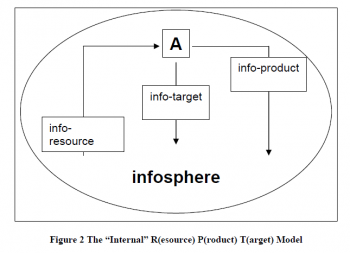Infosphere
The Infosphere is a term coined in the seventies, used in the field of Information Ethics to describe a collection of inforgs and how they interact with each other. Luciano Floridi defines the Infosphere as "the whole informational environment constituted by all informational entities (thus including informational agents as well), their properties, interactions, processes and mutual relations." [1] As described by Floridi, the growth of the Infosphere is roughly proportional to the growth of first, second, and third-order technologies interacting with Information and Communication Technologies (ICTs). Specifically, the growth of third-order technologies, in addition to the growth of third-order ICTs, precipitates the wider array of interactions that further comprise the Infosphere, in its conception by Luciano Floridi. The infosphere brings up a number of ethical concerns including social justice, socio-technical influence, and security, surveillance, and privacy issues.
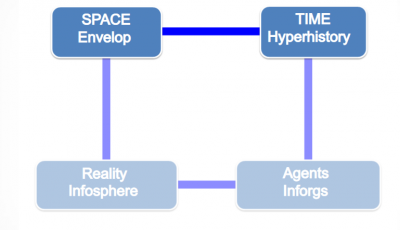
Origin
The first documented use of the term came in a 1971 Time Magazine book review by R.Z. Sheppard.[3] Later, in 1999, Luciano Floridi published "Philosophy and Computing: An introduction" [1], in which he gave his definition of an infosphere. The book was intended for philosophy students who needed IT literacy "to use computers efficiently or indispensable background knowledge for the critical understanding of our digital age."
Ontology of the Infosphere
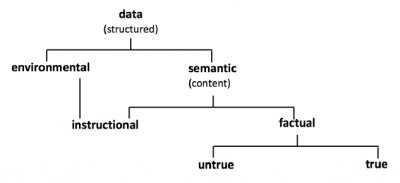
Information
The conception of the Infosphere borrows the conceptualization of information from the study of computation and information. Information takes the form of discrete pieces of knowledge. The issue is central in some of the more philosophical discussions on the nature of computation and information (Putnam 1988; Searle 1990). This conceptualization of information is also related to the notion of phase transitions in the description of nature (e.g., thermodynamics versus statistical mechanics) and to the idea of levels of abstraction (Floridi 2002).
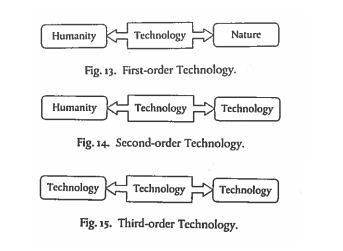
Nth-order Technologies
A first order technology connects a user to the prompter of an activity. A prompter is defined as the effect that causes the user to utilize technology in order to achieve a goal, thus "inviting technological mediation". In the case of a user whose goal is to preserve food, the prompter is food needing refrigeration, for example. A first-order technology is a technology that can be utilized as a tool to satisfy the prompter, with no mediation by a second technology. Examples include objects like a plough, wheel, umbrella, or axe, whose use-cases involve direct interference with the negative effect that the prompter demands to be negated. A plough directly causes a plot of land to be cultivated, a wheel directly enables high-efficiency transportation, an umbrella directly impedes rainfall, and an axe directly enables the production of lumber. Simple everyday technologies, like sandals, prompted by the need for protection from hot sand on a beach, falls under the category of first-order technology. [6] A second, third, and nth-order technology simply is defined by the number of mediating technologies involved in the interaction, with most examples comprised of computers interacting with other computers.
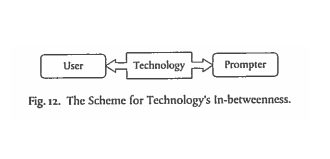
Information and Communications Technologies (ICTs)
The role of ICTs in the Infosphere is to "close the loop" of human-machine interaction, by converting a human-machine interaction, into a machine-machine interaction, removing the need for a user. Thus, ICTs serve the role of slowly eliminating the "in-between" property that technologies traditionally contain, within the Infosphere. Further, "ICT-friendly" technologies slowly convert a world conceptualized primarily physically, into a world conceptualized primarily informationally. The "in-between" property that Floridi describes, refers to the amount of physical presence that a technology imposes upon a user, in order for the user to achieve their desired application. As a third-order technology removes the need for a user-machine interaction, the relation between third-order technologies and ICT is one in which the user is able to achieve efficiency in their desired application, thus allowing for more "user-friendly" interfaces, through minimizing the "in-between" property of a particular technology.
Resource-Product-Target Model
The Resource-Product-Target (RPT) Model was proposed in Luciano Floridi's book "The Ethics of Information"[8], as an interpretation of ethics as microethics. The purpose of the model is to conceptualize information in an ontological conception, instead of a epistemological conception, where an agent is viewed as "embodied and embedded", as an "informational agent," within an "informational environment." Through the lens of Wikipedia in the context of information ethics, Wikipedia acts as a source for the study of moral issues, which demonstrates the Information as Resource phenomenon. In addition, Wikipedia acts as a product, in the sense where collaborative action yields the product of the information available on the platform. Finally Wikipedia acts as a Target, in the sense in which the integrity, quality, and value of the information can either be damaged or upheld. [9] In Figure 2, note how information flows to, and from arbitrary Agent A, within the RPT Model.
Applied Information Ethics
As identified by Floridi, the Digital Divide is the root source of most of the ethical concerns emerging in the infosphere.[10] The combination of a vertical divide between ages in today's society and a horizontal divide characterized by racial, ethnic, religious, and other divisions, has led to an age where ethical concerns arise due to a combined misunderstanding of how to interact in the ever-growing infosphere.[10]
James Moor identifies the fact that we need better ethics for technology and that with the rise of newer technologies, we must begin thinking about ethics as a part of the creation process rather than after the fact.[11] This aligns with Floridi's idea of the infosphere in that as the world transforms into an intertwined one (between natural and artificial agents), we must set better rules for ethics in technology production. Floridi mentions that the infosphere is "quickly evolving"[6] and Moor compliments this in establishing that we must consider potential ethical implications before technologies are released and have time to undergo negative impacts on information environments. Moor additionally writes that as technology becomes more fused into our every day lives, more ethical problems can be expected.[11]
Social Justice
Helen Nissenbaum criticizes Google searches conducted in 2011, in the case where limited representations of Black girls and women would appear on the first page of Google search engine results, in a way that neglected the "social, political, and economic aspects of Black women and girls' lives." While the response from Google caused their algorithm to shift the results on Black girls in August 2012, other women and girls of color including Latinas and Asians were left with hypersexualized subject matter being linked to by their search results. Regarding income inequality and the distribution of wealth, including "assets online and control over credible representative information," Nissenbaum claims that the result is a "weakening of democracy.[12]
Socio-Technical Influence
Nissenbaum, in her book Privacy in Context delineates the concept whereby a technology is defined not only by its utility and physical presence, but additionally, in terms of the economic, social, and cultural arrangements that surround the technology[13]. In the case where the technology is considered in terms of these economic, social, and cultural arrangements, Nissenbaum asserts that the technology then, can be described as socio-technical. In the case of the telephone, when considered excluding the socio-technical traits, the phone is considered a "box" that can communicate with other "boxes," that makes certain tones when keys are pressed, and possessing certain physical and ergonomic qualities. However, when considering the socio-technical traits of the telephone, the device is revealed to be an embedded device; one that has effects on "workplace hierarchy, on the home, on friendship, on the aged, on law enforcement, on urban development, and so forth." The telephone is further governed by more general "technical policies and social and cultural norms." Applying this paradigm to ethically relevant technologies with dire socio-technical influences, Nissenbaum engages primarily in indicting the technologies that are specifically "altering the flow of personal information in radically wrong ways." Examples include Radio Frequency Identification Technology (RFID), Vehicle Safety Communication Systems (VSCS), and healthcare monitoring systems.
Security, Surveillance, and Privacy
David Shoemaker asserts that a user's unrevealed information is a domain which, when encroached upon, is a violation of a user's autonomy, and is thus a violation of self-determination. An Infosphere is comprised of all the sum total of information possessed, and presented as a product or target for consumption. In the Infosphere, the risks of information privacy and surveillance surrounds the act of copying information, in addition to mining information. Shoemaker highlights that in the case where breaches of information privacy aren't an act of theft, or "cloning," there exist identity-affecting worries that we might have about them.[14]
Smart Technologies
As the world turns further into an Infosphere, people must be aware that smart technologies are becoming a part of daily life. An example of this breach of privacy is displayed by Amazon's smart speaker, Alexa. Amazon admittedly hires employees who are meant to listen to conversations had between customers and their Alexa products. This seems innocent when one learns that the intent of these employees is to better the technology, however, this type of surveillance becomes a privacy infringement when one learns that "reviewers are also listening on people's most personal moments." [15]
Diminishing Independence
As the infosphere continues to intertwine with the human world of interactions through introduction of new smart technology and digital applications into society, humans become increasingly more dependent on devices. While the innovations make life easier by simplifying previously tedious tasks, the cost of increased convenience is decreased autonomy for the human race. We are able to reap the benefits that technology provides by assigning unwanted work to machines, but in the future people could rely too heavily on their devices and give up their own talents and abilities by doing so.
See Also
References
- David Shoemaker (2010), Self-exposure and exposure of the self: informational privacy and the presentation of identity
- Luciano Floridi (2014), Privacy-Informational Friction
- David Gelernter (2000), The Second Coming, A Manifesto
- Helen Nissenbaum (2010), Privacy in Context: Technology, Policy, and the Integrity of Social Life
- ↑ 1.0 1.1 Floridi (1999), Philosophy and Computing: An introduction
- ↑ Hector Skinner (2016), Presentation on theme: "Luciano Floridi www.philosophyofinformation.net Research Chair in Philosophy of Information UNESCO Chair in Information and Computer Ethics University.
- ↑ “Infosphere.” Wikipedia, Wikimedia Foundation, 14 Aug. 2016, en.wikipedia.org/wiki/Infosphere.
- ↑ Floridi (2010), The Philosophy of Information: Ten Years Later
- ↑ Floridi (2014), Space, Infosphere
- ↑ 6.0 6.1 Luciano Floridi (2014), Space, Infosphere
- ↑ Floridi (2014), Space, Infosphere
- ↑ Luciano Floridi (2013), The Ethics of Information
- ↑ Paul Conway and SI410 Staff (2019), Wikipedia as Infosphere
- ↑ 10.0 10.1 Floridi, Luciano. “Ethics in the Infosphere.” The Philosophers' Magazine, no. 16, 2001, pp. 18–19., doi:10.5840/tpm20011647.
- ↑ 11.0 11.1 Moor, James. "Why we need better ethics for emerging technologies". Ethics and Information Technology. 2006.
- ↑ Nissenbaum (2010), Privacy in Context
- ↑ Nissenbaum (2010) Privacy in Context
- ↑ Shoemaker (2010), Self-exposure and exposure of the self: Informational privacy and the presentation of identity
- ↑ "Phil's Stock World: Busted: Thousands Of Amazon Employees Listening To Alexa Conversations" Weblog post. Phil's Stock World [Phil's Stock World - BLOG], Chatham: Newstex. 2019.
